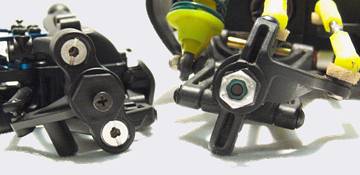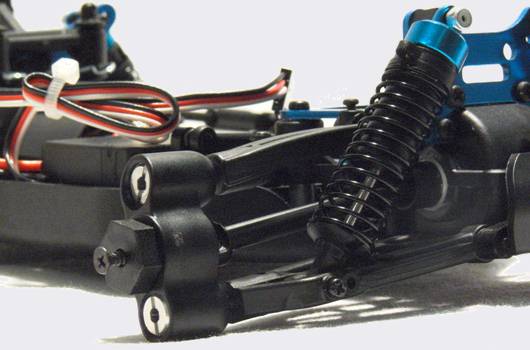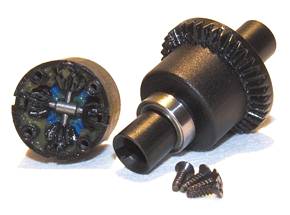|
» Deutsche
Fassung: hier klicken! |
LRP Shark 18 Monster
Review, Part
1
|
|
|
Small-sized
offroad(-cult) |
|
|
|
"Micro racing is fun!"
"Truggy-driving is cool!"
"Monster Trucks are the greatest!"
These are the three biggest trends that you
could experience as an R/C car driver in the last five years. All of
them brought loads of more or less sophisticated models to fill the
new classes and add some colour to the R/C car world.
LRP-Electronic
seems to aim at combining all those trends into one single car. How?
By building a small 1/18th scale truggy
and naming it "Monster"!
LRP offers their Shark 18 Monster in two versions: You have the
choice between the completely assembled (ARTR-) Truggy without any
rc-gear for about 149,90 Euros or you could go for the full
RTR-Package that includes anything you'd need as a hobby starter for
229,90 Euros.
For the this review
WR-RC-Racing
hooked me up with the RTR-version of the LRP Shark 18 "Monster"
The following remarks therefore refer to the test sample and
especially the measured values cannot be unrestrainedly generalized
due to serial dispersion.
Although "RTR" might sound like "unwrap and go"
such models should always be disassembled and checked. This can be
easily done thanks to the well illustrated manual which is also a
good reference for future maintenance work.
TECHNICAL
DATA
Length:
263mm
Wheelbase: 168mm
Width: 196mm
Height: 92mm
Weight: 730g
SUPPLEMENTARY
EQUIPMENT
27MHz
transmitter
servo, receiver
380-size motor, ESC
batteries for vehicle and transmitter, charger |
 |
All external hyperlinks marked
like this will be opened
in a new browser window!
|
|
|
Shark
18 Monster: The package |
|
|
|
As expected, LRP will
not let down their customers when it comes to funky package design.
The compact box features a ‚see-thru’ window while the coloured
cardboard is used to promote some spare- and hop-up parts. A small
photo gallery affirms to a still undetermined consumer that this
product has been developed and tested by some of the swell in the
(international) R/C car scene – well, then!
What has always counted more for us are the ‚inner values’. The RTR
kit is (nearly) absolutely complete: The Shark 18 has been equipped
with a Phaser 27 MHz (AM) receiver and an A.I. micro ESC – meaning
no cheap ‘RTR-edition’ components but regular, off-the-shelf LRP
products.
The transmitter is all standard: charging jack, trim and servo end
point adjustment for the steering are included and should be enough
for a start.
The additional equipment consists of a 600mAh battery to power the
Shark 18 Monster, a wall socket charger and eight (non-rechargeable) AA
cells for the transmitter.
While shopping, all newcomers should equip themselves with a set of
rechargeable transmitter batteries plus charger.

|
|
|
Shark
18 Monster in details |
|
|
|
"solid"... "overcrowded" ... "cute!"
Guess those were my first thoughts when I had delivered the little
truggy from its bodyshell.
Luckily, the crowded look only comes from the standard components
that the Shark 18 Monster is fitted with. Using mini-components (micro
servo, small FM-receiver from a slow-flyer) the chassis would
certainly look more orderly, but parts in standard size are quite
tough and budget-priced.

The chassis actually debuted with the Shark 18 buggy – which LRP
promoted as a scaled-down 1/8th buggy. Just as well, because the
dimensions of the chassis remind more of a gas powered vehicle than
of a frail electric car. The construction itself is a clever mix of
both types with some intriguing details. The chassis hasn’t been
changed for the Monster model, but the suspension has been made wider,
featuring a PBS-suspension at the front.
|
The electronics can be (apart from the
taped-in servo) quickly removed from the chassis because they are
mounted onto the battery strap. Down below you can see much more of
the chassis. It's of a ‘tub-type’ with lots of things moulded to it,
hence the Shark 18 Monster consists of a surprisingly small number of
parts.
The chassis comes with the lower halves of the gearboxes, all
supports for the drive train and the inner hinge pin mounts.
If it weren’t only twenty centimetres long you could think of a
1/10th scale chassis because the thickness of 2.5 millimetres seems
quite beefy with the small scale. The plastic is reassuringly stiff
and light – it seems to be fibre-glass reinforced nylon. All
stressed parts are secured with 2.6 millimetre tapping screws.
|
 |
|
|
|

The
design of the front suspension is very close to the
1/8th scale buggy concept. Due to the pivot ball
suspension the upper arm has to support the steering arm
and can therefore not use a tie rod. The whole steering
construction reminds of the bigger-scale ancestors as
well. The double linkage of the steering itself is more
of the 1/10th standard again, while the servo –deprived
of its mounting lugs- is held in place only by a patch
of double-sided adhesive tape. |
|

The cast-aluminum motor
mount is a firm base for the 380-size motor and also
quickly dismantled by loosening two screws. The
construction of the Shark 18 would make it quite tricky
to adjust the meshing between pinion and main gear,
hence blue anodized adaptor plates with fixed mounting
holes are used. This way, five different pinion gears
can be used. (11, 13, 16, 19 and 21 teeth)
A precisely fitting gear cover protects everything from
dust and also stiffens this critical part of the chassis
at the same time. |
|

Why be
complicated when there’s an easy way? Instead of
attaching frail hinge pin holders, LRPs’ Shark 18
Monster
uses all of the tub chassis and integrates the hinge pin
mounts into it. The rear end uses a ball-type design
which makes everything more crash-proof and allows the
use of different toe-in blocks. |
|
|
|
|
Suspension |
|
|
The Shark 18 Monster comes with a
PBS-system at the front and conventional hub design at the rear
suspension. Four oil filled shocks provide remarkable 3 centimetres
of travel (depending on the position of the shock on the lower arm
and the shock tower)
|
|
PBS-systems are a little trickier to
set up due to their construction but LRP found a clever solution to
compensate this: The arms got a little ‘peephole’ – when the thread
of the pivot ball is half way in, the setup is OK. Fly, huh?

PBS-systems are a bit more
sensitive to crashes because of the bigger leverage forces (like on
the pivot ball thread which is screwed into the suspension arm)
Hence these suspensions are normally built more ruggedly than
conventional c-hub systems. The Shark 18 Monster is no exception here:
Its steering arms could compete with a Team Losi XXX-4 (1:10) buggy.
 |
|
What is a pivot ball suspension?
At the front the
suspension has to allow movements in two ways: up and
down for the shocks, left and right for the steering.
With conventional c-hub systems these two directions of
movement are performed by two separate parts: The c-hub
allows vertical movement and inside of it you find the
steering arm which can move horizontally.
The pivot ball suspension uses one single
suspension part that is able to move in both axes which
is realised by using, well, balls

The steering arm
contains two massive ball supports which can be set up
without any play by the help of aluminum inserts.
Depending on how far the steel balls are screwed into
the suspension arms you can adjust the caster – and with
a three-ball PBS even the toe-in at the rear suspension.
More on this in the
R/C-clopedia! |
|
|
The suspension arms are made of a more flexible material but this
shouldn’t have any negative effects on the whole construction. In
order not to overstress the shocks, the arms have lugs on the
underside to limit the maximum suspension travel. |
|
Now that we’re talking about shocks: Luckily LRP equipped the Shark
18 Monster with full-fledged oil filled shock absorbers. Alas, they
cannot keep up with the excellent quality of the chassis as they are
sloppily filled.
But filled correctly (the diaphragm could be a bit bigger too!)
they’re really smooth and soft. Unfortunately the manual doesn’t
tell about the actual oil that the shocks have been filled with but
20WT/200cps should be just about right.
Also the spring preload needs a bit of help: one clip at each front
shock and two at the rear will make the suspension arms stay level
to the ground and provide for remarkable 15 millimetres of ground
clearance.
As you can see on the pictures on the right the whole suspension can
do without e-clips: the hinge pins are kept from falling out by the
front bumper or the rear plate respectively. The rear-hub pins are
held by a (really firm) press fit.
|


 |
|
You can
be quite inventive when setting up the Shark 18 Monster:
The shocks have two positions on each suspension arm and three at
the shock tower in order to master any surface that you can think
of. The caster of both front and rear suspension can be adjusted
while the toe-in remains fixed.
|
|
|
A
Centershaft, two diffs, four universals and a few ball bearings |
|
|
|
Unlike in bigger scale 1/10ths’ or even 1/8ths’ everything could be
quite simplyfied for this mini-truggy: Thanks to the stiff chassis
there was no need to separate the bevel gears from the main shaft
but simply stick them onto the 5-millimetre aluminium shaft. The
bearing of the central shaft is realised by the bevel gears and the
spur gear so that there remains a bit of flexibility from the
plastic chassis.
|


|
|
 |
Simple and rugged: Thanks to a lot of plug-connections
(also at the diff-outdrives) the whole driveline is
quickly dismantled. The diff outdrives are made of
plastic as well, but thanks to their closed design they
do not need any outdrive-saver rings.
|
 |
|
The bevel gears run smoothly out of the box and without
being notchy. Gears and diff innards are packed tightly
with sticky grease (which has been removed for the
photos, as far as possible)
|
|
 |
|
Contrary to the good impression that the Shark 18
Monster
has made so far, you have to ask yourself what LRP might
have had in mind while designing their universal shafts:
Compared to the four-millimetre aluminum main shaft
these three millimetre plastic shafts (which have to
transfer three to four times the torque) look rather
‘provocative’ - to put it in a nice way.
The only metal part in the shaft is the drive pin; even
the cardan joint is made of plastic and engages with a
nearly one-millimetre lug. There would be enough space
to make the prop shafts 50 percent bigger.
"And that works?" – more of a rhetorical question, but
we will see!

I definitely like the idea that LRP decided to use the
widespread 12-millimetre wheel hex for the Shark 18. So
it is no problem to use 1/10th sedan tires when the
track allows it. However you will need a screw with a
bigger head or a small shim to attach it securely.
|
|
|
|
Checkpoint! |
|
|
|
LRP's Shark 18 Monster – a
1/18th scale truggy with lots of clever details, supreme quality in
assembly plus material and ...
… universal shafts that don’t want to have anything to do with the
rest of the car; or at least make you want to believe that..
The whole truggy is purpose-built: as simple as possible without
compromising stability or suspension geometry. So it doesn’t come as
a surprise that the Shark 18 can be almost completely disassembled
in about ten minutes.
The quality of the RTR assembly is excellent for the most part:
Every screw is tight, the suspension is set up and also the wiring
leaves nothing to be desired.
The sloppily filled shocks are a nuisance and with the wing stay I
had to find a damaged thread – annoyingly, in the chassis.
Text and pictures by
Aaron Banovics
Translation by Markus
Simon
This review has been published on
www.offroad-cult.org
on 02-10-2007.
|
|

|